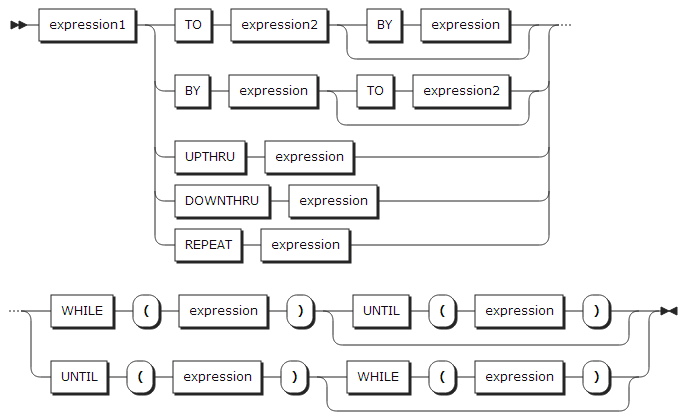1. DO Statement
The DO statement defines conditions for repeated execution on a multiple statements groups. A DO statement must be used along with an END statement. Statements between a DO statement and an END statement are grouped as a do-group.
A DO statement can be one of the following types:
-
Type 1
-
Type 2
-
Type 3
-
Type 4
Type 1
Type 1 defines a do-group and executes statements within the do-group. Type 1 does not define conditions for repeated execution.

Type 2 and Type 3
Type 2 and Type 3 define a do-group and executes statements within the do-group. They can define conditions for repeated execution.
Type 2:

Type 3:

specification:

| Component | Description |
|---|---|
WHILE(expression) |
Evaluates an expression and converts it to a BIT string before executing a do-group. If any BIT in a string are 1, a do-group will be executed. If all BITs are 0 or a string is NULL, a do-group will not be executed. If there are multiple specifications, the next specification will be executed. |
UNTIL(expression) |
Evaluates an expression and converts it to a BIT string after executing a do-group. If all BITs in a string are 0 or the string is NULL, a do-group will be executed. If any BIT is 1, a do-group will not be executed. If there are multiple specifications, the next specification will be executed. |
reference |
The value of expression1 will be used for initialization before executing a do-group. If there are multiple specifications, each specification’s value of expression1 will be used for initialization. |
expression1 |
Initial value of a reference. If TO, BY, and REPEAT are omitted, the value of expression1 will always be used for initialization. |
TO expression2 |
The end value of a reference. If a value of a reference is not in the range of values between expression1 and expression2, a corresponding do-group will be ended. If TO expression2 is omitted, a do-group will be ended by the WHILE or UNTIL options. |
BY expression |
Increment to a reference. A reference is added by the value of an expression after executing a do-group. If TO expression2 is specified and BY expression is omitted, BY 1 will be the default value. |
UPTHRU expression |
The end value of a reference. A reference is increased by 1 and saved after executing a do-group. The TO option is compared before executing a do-group but the UPTHRU option is compared after executing a do-group. Therefore, the UPTHRU option allows a do-group to be executed at least once. |
DOWNTHRU expression |
The end value of a reference. A reference is subtracted by 1 and saved after executing a do-group. The TO option is compared before executing a do-group but the DOWNTHRU option is compared after executing a do-group. Therefore, the DOWNTHRU option allows a do-group to be executed at least once. |
REPEAT expression |
The expression is evaluated, the result value is saved to a reference, and a do-group is executed. A do-group execution is repeated until ended by the WHILE or UNTIL options. |
Type 4
Type 4 defines a do-group and executes statements within the do-group repeatedly and infinitely.

| Component | Description |
|---|---|
FOREVER |
Same as LOOP. |
LOOP |
Sets infinite repetition. To end the repetition, use a GOTO or LEAVE statement or end the procedure or program. |